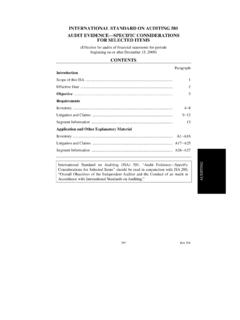Transcription of 134-2013: Tips for Generating Percentages Using the SAS ...
1 SAS Global Forum 2013 Foundations and Fundamentals Paper 134-2013. tips for Generating Percentages Using the SAS TABULATE Procedure Kathryn McLawhorn, SAS Institute Inc. ABSTRACT. PROC TABULATE is one of the few Base SAS procedures that calculate Percentages . The procedure is unique in that it has many default statistics for Generating Percentages and also provides the ability to customize denominator definitions. Determining the right denominator definition is an important but often challenging aspect of calculating Percentages . Written for intermediate users, this paper discusses techniques for enhancing PROC TABULATE output with percentage statistics. Using examples, the paper illustrates how to add standard Percentages to the PROC. TABULATE output, and it shares tips for calculating Percentages that you might have thought not possible.
2 The paper also illustrates how to avoid common pitfalls that are related to structuring denominator definitions and how to format table output. INTRODUCTION. In the earliest SAS release, PROC TABULATE included only the PCTN and PCTSUM statistics for calculating Percentages . However, determining the correct denominator definition to get the desired percentage was tricky. The statistics introduced in a subsequent release (SAS 7) simplified some common percentage requests. These statistics include COLPCTN, COLPCTSUM, PAGEPCTN, PAGEPCTSUM, REPPCTN, REPPCTSUM, ROWPCTN, and ROWPCTSUM. This paper provides examples of standard percentage requests, including some challenging requests in which denominator definitions are required. Examples also show special percentage requests that require manipulating the data in advance.
3 Included are tips for avoiding common mistakes when you construct denominator definitions. Finally, you learn techniques for applying formatting to enhance percentage statistics in PROC TABULATE output. Note that most of the examples in this paper use the CARS data set that is found in the SASHELP library. For all examples, the following statements are submitted at the beginning of the code: options nocenter nodate nonumber linesize=100;. title;. STANDARD PERCENTAGE REQUESTS. Before you can learn how to enhance your PROC TABLUATE output, you first need to understand how to use the default statistics to calculate Percentages . You can then build on that knowledge by learning how to construct custom denominator definitions. It is also helpful to know how percentage statistics are named in an output data set that is created by PROC TABULATE.
4 UNDERSTANDING AND Using DEFAULT PERCENTAGE STATISTICS. The PCTN family of statistics includes COLPCTN, PAGEPCTN, REPPCTN, and ROWPCTN. The Percentages that are generated from these statistics are based on the frequency count (N) of the whole report or on the specific page, column, or row. The PCTSUM family of statistics includes PCTSUM, PAGEPCTSUM, COLPCTSUM, REPPCTSUM, and ROWPCTSUM. The Percentages that are generated from these statistics are based on summarized values (SUM) within the whole report or on the specific page, column, or row. The PCTSUM family of statistics requires nesting with a numeric analysis variable. The examples in the following sections show you how to calculate Percentages with some of these statistics. The REPPCTN and REPPCTSUM Statistics The REPPCTN and REPPCTSUM statistics generate the same results as the PCTN and PCTSUM statistics without a denominator definition.
5 They print the percentage of the value in a single table cell in relation to the total of the values in the report. The REPPCTN statistic is used in the following example. The resulting table is shown in Output 1. proc tabulate data= format= ;. class origin type;. table type all, (origin all)*(n*f=8. reppctn) / rts=10;. run;. 1. SAS Global Forum 2013 Foundations and Fundamentals Output 1. Output Showing the Results Generated by the REPPCTN Statistic The COLPCTN and COLPCTSUM Statistics The COLPCTN and COLPCTSUM statistics print the percentage of the value in a single table cell in relation to the total of the values in the column. The COLPCTN statistic is used in the following example. The resulting table is shown in Output 2. proc tabulate data= format=.
6 Class origin type;. table type all, (origin all)*(n*f=8. colpctn) / rts=10;. run;. Output 2. Output Showing the Results Generated by the COLPCTN Statistic The ROWPCTN and ROWPCTSUM Statistics The ROWPCTN and ROWPCTSUM statistics print the percentage of the value in a single table cell in relation to the total of the values in the row. The ROWPCTSUM statistic is used in the following example. The resulting table is shown in Output 3. 2. SAS Global Forum 2013 Foundations and Fundamentals proc tabulate data= format= ;. class origin type;. var msrp;. table type all, (origin all)*msrp*(sum*f=dollar10. rowpctsum) / rts=8;. run;. Output 3. Output Showing the Results Generated by the ROWPCTSUM Statistic The PAGEPCTN and PAGEPCTSUM Statistics The PAGEPCTN and PAGEPCTSUM statistics print the percentage of the value in a single table cell in relation to the total of the values in the page.
7 The PAGEPCTN statistic is used in the following example. The resulting table is shown in Output 4. proc tabulate data= format= ;. class cylinders origin type;. table cylinders, type all, (origin all)*(n*f=8. pagepctn) / rts=10;. run;. Output 4. Output Showing the Results Generated by the PAGEPCTN Statistic 3. SAS Global Forum 2013 Foundations and Fundamentals CONSTRUCTING A CUSTOM DENOMINATOR DEFINITION. The default percentage statistics enable you to obtain basic calculations, but they might not give you the percentage that you actually need. For example, you want a percentage that reflects a subtotal in the table. In this case, PROC. TABULATE gives you the ability to build your own denominator definition. The denominator definition uses PCTN or PCTSUM as a starting point.
8 Then, in angle brackets (<>) after the statistic name, you specify an expression that tells PROC TABULATE which values should be used to calculate the denominator for the percentage that you request. These expressions can include the following: a single variable (a class variable or an analysis variable). a class variable and the ALL universal class variable crossings of class variables crossings of class variables and the ALL variable crossings that contain class variables and one analysis variable concatenations of any of the items above Note that all class variables used in a denominator definition must appear in a dimension expression in the TABLE. statement. Determining which denominator definition is correct to use can be challenging. It is not always intuitive which expression you should use when you are constructing the denominator definition.
9 In addition, if there are concatenated elements in an expression, the order of the elements matters. Whereas several combinations of expressions might produce output, not all combinations produce the desired percentage. Consider what is required when you create a subtotal percentage. The table consists of multiple subtables, so you need to figure out which combinations of the class variables and, if included, the ALL variable, contribute to each subtable. A strategy for creating more complex denominator definitions starts with simplifying the TABLE statement: Remove all formats, statistics, and labels. Eliminate any parentheses by distributing (multiplying out) the variables. The resulting TABLE statement should include simply the variable names, asterisks, and commas.
10 Next, determine the list of possible denominators. Two denominators that always work are the entire column dimension and the entire row dimension. Some other possible denominator definitions include one item from each of the parts that make up the row or column dimension. With the following sample TABLE statement, where A, B, C, and D are defined in a CLASS statement, you can use the process described above to discover potential denominator definitions: table A*B, C D;. Expanding the crossings in the table results in A*B*C A*B*D. Here are possible denominator definitions for this table: A*B. C D. A. B. A*C A*D. B*C B*D. As shown above, a good way to obtain a better understanding of this concept is to experiment with different combinations of valid denominators for the PCTN statistic.
















